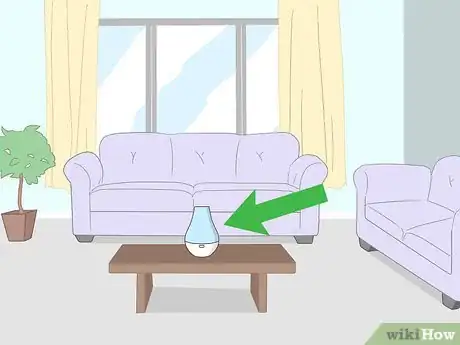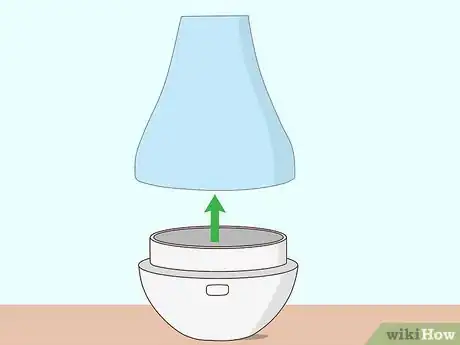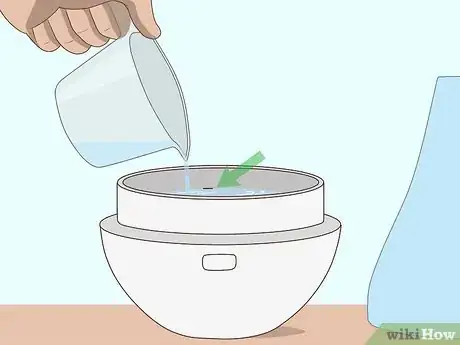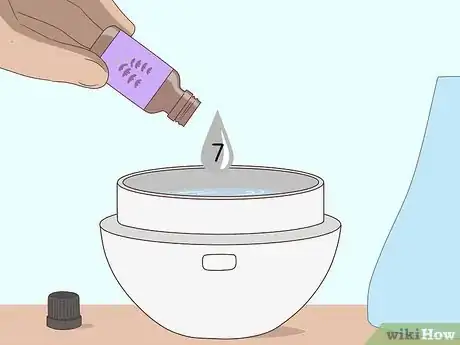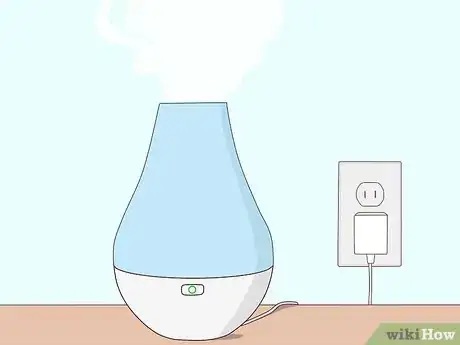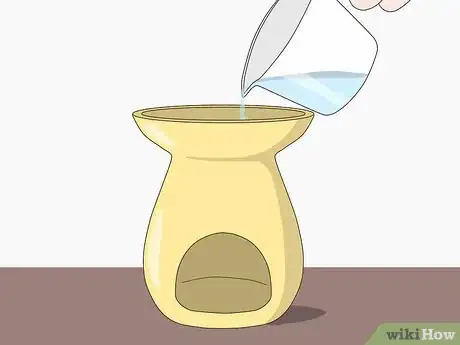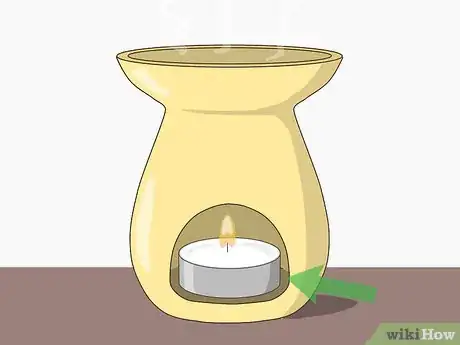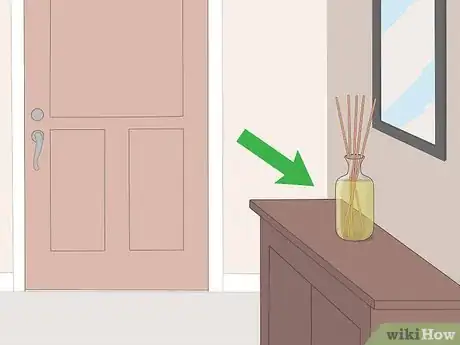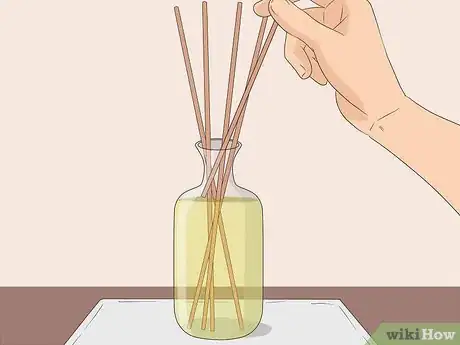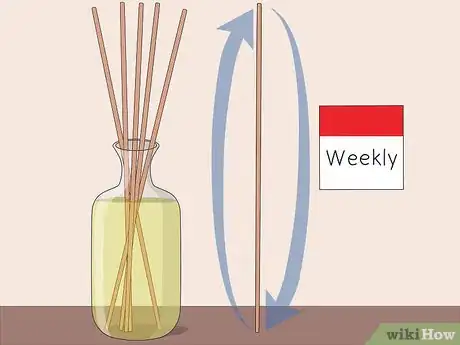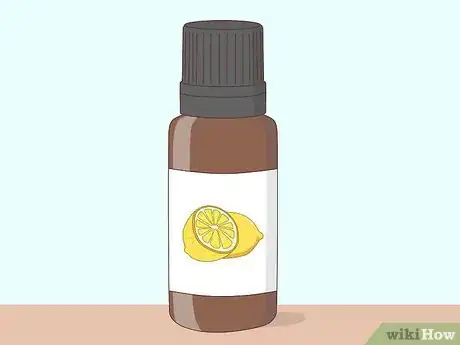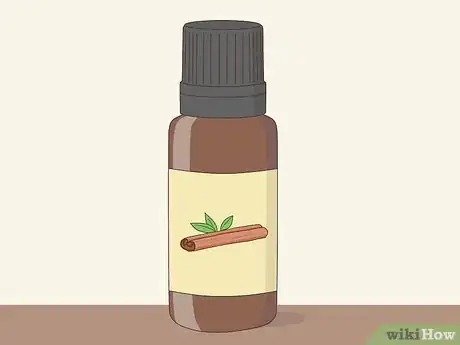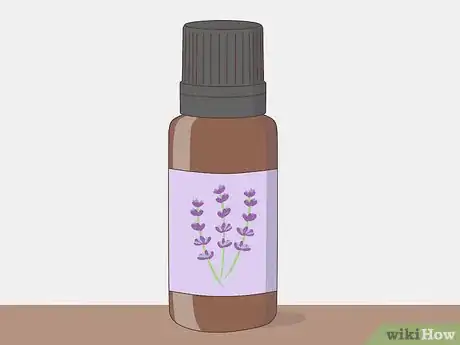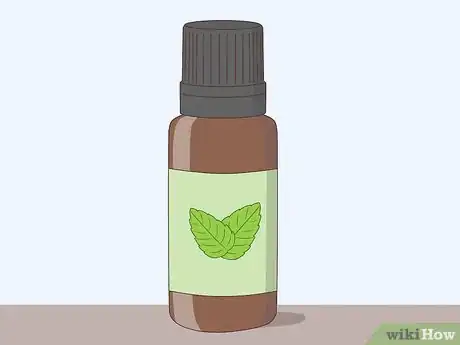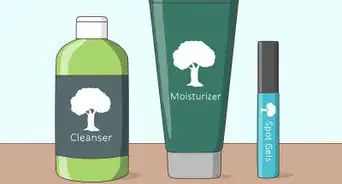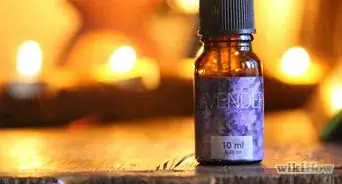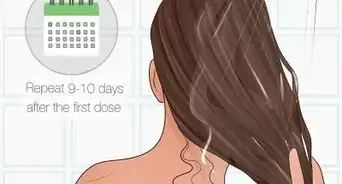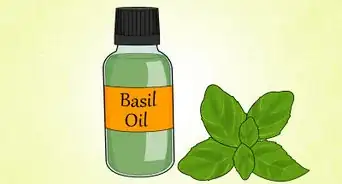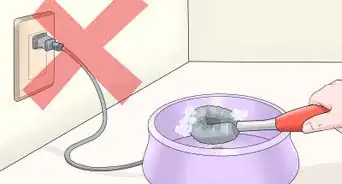This article was co-authored by Julie Brow-Polanco. Julie Brow-Polanco is a Master Herbalist & Certified Aromatherapist with more than 11 years of experience. She is an expert on natural remedies and specializes in using them to support whole-body wellness, particularly immune, digestive, nervous, and reproductive health. Julie earned a Bachelor's Degree in Psychology from Dominican University, a Master Herbalist Certification from The School of Natural Healing, and a Certificate of Aromatherapy from the Pacific Institute of Aromatherapy. Julie is a member of the American Herbalist Guild and a Certified Aromatherapist through the National Association of Holistic Aromatherapy.
There are 15 references cited in this article, which can be found at the bottom of the page.
This article has been viewed 222,430 times.
Diffusing essential oils is a great way to improve the aroma of any room. There are several different types of oil diffuser, but all of them are equally easy to use. Fill the diffuser only to the maximum level, use the right amount of oil, and keep an eye on it as it works for the best results.
Steps
Using an Electric Diffuser
-
1Place your diffuser near the middle of the room. Oil diffusers will release a fine mist of water to diffuse the oils around your room. Place your diffuser near the center of your chosen room to let the oil distribute evenly around the space. Keep it on a flat surface to prevent anything from spilling or falling over while your diffuser is running.[1]
- Put a towel down underneath the diffuser to catch any excess water while the diffuser runs. If the towel remains dry after the first few times using it, it probably isn’t needed.
- You’ll also need a power outlet nearby if your diffuser needs to be plugged in.
-
2Lift the top off of your diffuser. While it may differ slightly between different types of diffusers, most will have a top casing that can be lifted off to reveal the reservoir. Try rotating, popping, or even just lifting the top of your diffuser to open it and get access to the internal water tank.[2]
- If you’re unsure how to open your diffuser, check the manufacturer's guide for instructions specific to your diffuser.
- Some diffusers may have two tops that need to be removed to access the reservoir. One will normally be decorative, where the other is used to trap excess moisture. If you remove the top of your diffuser and see another casing instead of a tank, remove this interior casing as well.
Advertisement -
3Fill the diffuser with room temperature water.[3] Fill a small measuring cup or glass with water that is around room temperature, or below your body temperature. Carefully pour the water into the reservoir or internal tank of your diffuser. Check for a line or marking on the inside of the tank to indicate how much water you should pour into the tank.[4] [5]
- Rather than a line or marker, some diffusers may come with a measuring jug that holds exactly the right amount of water for the reservoir. Fill this up with water and pour it into the tank.
- Room temperature is around 69 °F (21 °C). Put a finger in the water to test it, looking for water that is slightly cool but not cold.
-
4Add 3 to 10 drops of essential oils to your diffuser.[6] Unscrew the cap on your chosen essential oil and tilt it directly over the water reservoir. You may need to slightly shake it, but drops of oils should begin falling into the water. Let around 6 or 7 drops fall in before tilting the bottle back and putting the cap back on.[7]
- You can combine different types of essential oils, but you should only put a maximum of 10 drops into your diffuser. Use a few drops of each oil that you want to prevent an overpowering aroma when you turn your diffuser on.
- Keep track of how many drops of oil you use for each operation so you can get a better sense of how much you need. For a smaller room, you might only need 3 or 4 drops. Start lower and increase the amount of oil you use until you’re happy with the aroma.
-
5Replace the top of your diffuser and turn it on.[8] Put the lid or casing of the diffuser back over the reservoir, making sure it is sitting properly. Turn the diffuser on at the wall and use the button or switch on the front of the diffuser to let it start running.[9]
- Some diffusers may have multiple settings or lights that you can use to adjust its operation. Check your manufacturer’s instructions if you’re unsure how to make your diffuser work, or to see how to use these more advanced settings.
Using a Candle Diffuser
-
1Put your diffuser in a high traffic area of your room. As the water evaporates with the help of the candle, it’ll start releasing the aroma of your chosen oil. Place the diffuser somewhere the movement of people or a gentle breeze will help distribute the oil aroma. Keep it on a flat surface, in a high-traffic and central part of the room for the best results.[10]
- People moving around it will help distribute the oil, but will also increase the chance of it being knocked over. Make sure the diffuser is kept in a safe place first.
-
2Fill the reservoir with water.[11] Fill a glass or small measuring jug with water and pour it into the reservoir on top of the diffuser. Some diffusers may have a line or indicator to guide how much water you should add to the reservoir. If not, fill it around halfway to reduce the chance of water spilling.[12]
- Always consult the manufacturer’s instructions for advice on your specific diffuser.
- Make sure you put the water in before you add any oils.
-
3Add 2 to 4 drops of essential oil to the water. Unscrew the lid of your chosen oil and tilt it over the water reservoir to begin slowly adding drops. Let 2 or 3 drops fall into the water before tilting the bottle back and putting the lid back on.[13]
- Combine different oils for a more complex aroma, but avoid using more than 4 drops of oil combined in a candle diffuser.
- The amount of oil needed will vary based on the size of your room. Start with fewer drops and increase the amount of oil you use until you’re happy with the aroma.
- Keep track of how many drops of oil you use for each operation so you can get a better sense of how much you need. For a smaller room, you might only need 3 or 4 drops. Start lower and increase the amount of oil you use until your happy with the aroma.
-
4Place a candle under the reservoir and light it. Place a small candle, such as a tealight or something similar, in the space underneath the reservoir. Use a match or long lighter to set the candle alight, and leave it for 3 to 4 hours to diffuse the oils.[14]
- Keep an eye on your candle and diffuser as it works, to make sure the candle doesn’t go out by itself.
- Once the water in the reservoir has mostly evaporated, or you cannot see the oil anymore, blow the candle out.
Using a Reed Diffuser
-
1Place your diffuser somewhere central in your room or home. The reed diffuser is the most passive way to diffuse oil around your home, so it needs movement to distribute the aroma around. Keep your diffuser in a high-traffic, central area of your room or home for the best results.[15]
- Try placing the diffuser near the main entryway to the room, so you get a fresh hit of your chosen oil everytime you go into the room.
-
2Pour essential oil into the reservoir. Most reed diffusers will come with a bottle of oil designed of the right strength for the diffuser. Pour the oil into the mouth of the diffuser, being careful not to spill any over the sides.[16]
- Unlike other diffusers, reed diffusers don’t allow you to swap out new scents easily. Pick an oil that you like for long-term usage.
- There’s no right amount of oil to pour into the diffuser. Some people will pour in the whole bottle, others will add a little at a time to keep the oil fresh.
-
3Add the reeds to the diffuser. Bunch the reeds together and carefully drop them into the mouth of the diffuser. Spread them out so they are separate and all point in different directions for a more even diffusion of oil. The oil will begin absorbing into the reeds and slowly filling your room with the aroma of the oil.[17]
- The more reeds that you use, the stronger the aroma will be. For a smaller room, you may only want to use 2 or 3 reeds.
- Adding the reeds may cause the oil in the diffuser to overflow if it’s already very full. Be careful when adding the reeds, or do so over a sink to prevent spillage.
-
4Flip the reeds to refresh the oils and the aroma. Every week or so, you may notice that the aroma from the oil begins to fade. Lift the reeds out of the diffuser and flip them over, so the end that was soaking in the oils is now facing upward. This should refresh the aroma for another week or so until you flip them again.[18]
- It may help to flip the reeds over a paper towel or over your sink to catch any stray oils.
Choosing an Oil
-
1Use lemon oil for a fresh, citrusy aroma.[19] Lemon oil is one of the more popular oils for a range of products, including use as an essential oil in a diffuser. Use a few drops to fill your home with the citrusy sharpness of lemon. Some studies have even shown benefits of using lemon oil to improve your mood or to reduce stress![20]
- Use a combination of lemon, peppermint, and rosemary oil for an energizing blend of aromas.[21]
-
2Choose cinnamon oil for a fresh-baked cinnamon roll scent.[22] Cinnamon oil has a sweeter, warmer smell to it than lemon, and so makes a great scent for those dark winter months. Use a few drops of cinnamon oil to make your home smell like you’ve got cinnamon rolls in the oven all day long.[23]
- Try combining orange, ginger, and cinnamon oils for an amazing fall scent perfect for Thanksgiving.[24]
-
3Go with lavender oil for a calming, floral aroma.[25] Lavender oil may be the most popular and the most common essential oil, but it’s definitely for a good reason. Use a few drops of lavender oil to give your home a beautifully fresh and floral scent, as well as potentially helping you fall asleep if you use it in the evening.[26]
- Use a mixture of lavender, grapefruit, lemon, and spearmint oil for a delightful summertime blend of aromas.[27]
-
4Opt for peppermint oil to keep you awake and alert. The sharp, yet somewhat sweet smell of peppermint will freshen up your home and may even keep you more awake and focused. Use a few drops of peppermint oil to fill your home with a familiar, minty smell.[28]
- Mix equal quantities of peppermint oil and eucalyptus oils for an aroma that will help clear your sinuses and may help you breathe better.[29]
Warnings
- Essential oil diffusion may be harmful to your pets. Consult your vet or look online for further advice before using essential oils around animals.⧼thumbs_response⧽
- Be careful not to spill any water from the diffuser while it is running, as this may lead to electrocution or electrical faults.⧼thumbs_response⧽
- Always read and follow the manufacturer’s instructions and warranty for your specific oil diffuser.[30]⧼thumbs_response⧽
References
- ↑ https://youtu.be/Oe8gDcBGcao?t=41
- ↑ https://youtu.be/IpHiRUFJcck?t=8
- ↑ Julie Brow-Polanco. Master Herbalist & Certified Aromatherapist. Expert Interview. 12 April 2022.
- ↑ https://youtu.be/Oe8gDcBGcao?t=61
- ↑ Julie Brow-Polanco. Master Herbalist & Certified Aromatherapist. Expert Interview. 12 April 2022.
- ↑ Julie Brow-Polanco. Master Herbalist & Certified Aromatherapist. Expert Interview. 12 April 2022.
- ↑ https://youtu.be/Oe8gDcBGcao?t=102
- ↑ Julie Brow-Polanco. Master Herbalist & Certified Aromatherapist. Expert Interview. 12 April 2022.
- ↑ https://youtu.be/IpHiRUFJcck?t=47
- ↑ https://youtu.be/cqbeFXw-VhQ?t=120
- ↑ Julie Brow-Polanco. Master Herbalist & Certified Aromatherapist. Expert Interview. 12 April 2022.
- ↑ https://youtu.be/HUg9_0Bj84U?t=10
- ↑ https://youtu.be/HUg9_0Bj84U?t=16
- ↑ https://youtu.be/HUg9_0Bj84U?t=23
- ↑ https://youtu.be/cqbeFXw-VhQ?t=120
- ↑ https://youtu.be/CocKbiW-SX0?t=70
- ↑ https://youtu.be/CocKbiW-SX0?t=108
- ↑ https://youtu.be/cqbeFXw-VhQ?t=167
- ↑ Julie Brow-Polanco. Master Herbalist & Certified Aromatherapist. Expert Interview. 12 April 2022.
- ↑ https://www.wellandgood.com/good-looks/10-best-essential-oils/
- ↑ https://redefinedmom.com/57-essential-oil-diffuser-blend-recipes-for-mind-body-soul/
- ↑ Julie Brow-Polanco. Master Herbalist & Certified Aromatherapist. Expert Interview. 12 April 2022.
- ↑ https://www.wellandgood.com/good-looks/10-best-essential-oils/
- ↑ https://redefinedmom.com/57-essential-oil-diffuser-blend-recipes-for-mind-body-soul/
- ↑ Julie Brow-Polanco. Master Herbalist & Certified Aromatherapist. Expert Interview. 12 April 2022.
- ↑ https://www.wellandgood.com/good-looks/10-best-essential-oils/
- ↑ https://redefinedmom.com/57-essential-oil-diffuser-blend-recipes-for-mind-body-soul/
- ↑ https://www.wellandgood.com/good-looks/10-best-essential-oils/
- ↑ https://redefinedmom.com/57-essential-oil-diffuser-blend-recipes-for-mind-body-soul/
- ↑ Julie Brow-Polanco. Master Herbalist & Certified Aromatherapist. Expert Interview. 12 April 2022.
About This Article
Using an oil diffuser to improve the aroma of any room is an easy process. Place your diffuser near the middle of the room to let the oil distribute evenly around the space. Keep it on a flat surface to prevent anything from spilling of falling over. You’ll also want to put a towel under the diffuser to catch any excess water. If your diffuser needs to be plugged in, make sure your setup is near an outlet. For an electric diffuser, lift the top off and fill the small measuring cup or glass with room-temperature water. Add 3 to 10 drops of essential oil to the water reservoir before replacing the top and turning the diffuser on. To learn how to use a reed or candle diffuser, keep reading!
